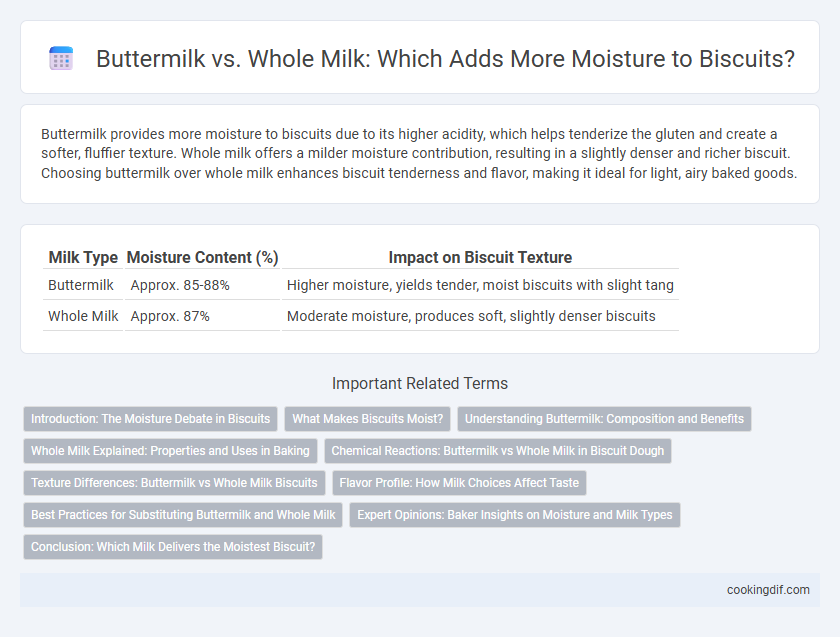Buttermilk provides more moisture to biscuits due to its higher acidity, which helps tenderize the gluten and create a softer, fluffier texture. Whole milk offers a milder moisture contribution, resulting in a slightly denser and richer biscuit. Choosing buttermilk over whole milk enhances biscuit tenderness and flavor, making it ideal for light, airy baked goods.
Table of Comparison
| Milk Type | Moisture Content (%) | Impact on Biscuit Texture |
|---|---|---|
| Buttermilk | Approx. 85-88% | Higher moisture, yields tender, moist biscuits with slight tang |
| Whole Milk | Approx. 87% | Moderate moisture, produces soft, slightly denser biscuits |
Introduction: The Moisture Debate in Biscuits
Buttermilk enhances biscuit moisture with its higher acidity and thicker texture, creating a tender crumb and richer flavor compared to whole milk. Whole milk provides moderate moisture and a milder taste, but lacks the tangy complexity that buttermilk imparts. Bakers often prefer buttermilk to achieve a moist, soft biscuit with an appealing rise and subtle tanginess.
What Makes Biscuits Moist?
Buttermilk enhances biscuit moisture due to its acidic content, which reacts with baking soda to create tender, fluffy textures by breaking down gluten more effectively than whole milk. Whole milk provides a richer fat content that contributes to a soft crumb but offers less chemical leavening activation. The combination of acidity in buttermilk and fat in milk directly influences the moisture retention and tenderness of biscuits, making buttermilk the preferred choice for moist, delicate results.
Understanding Buttermilk: Composition and Benefits
Buttermilk contains lactic acid and a lower fat content compared to whole milk, which enhances biscuit tenderness by subtly breaking down gluten and improving moisture retention. Its acidic nature also promotes better rise through reaction with baking soda, resulting in fluffier, softer biscuits. Using buttermilk in biscuit recipes yields a moist, tender crumb and a slightly tangy flavor profile that complements savory or sweet variations.
Whole Milk Explained: Properties and Uses in Baking
Whole milk contains approximately 3.25% fat, providing richer moisture retention and a tender crumb in biscuit dough compared to buttermilk, which is more acidic. The higher fat and protein content in whole milk contribute to improved browning and a softer texture, essential for flaky, moist biscuits. Additionally, whole milk's balanced composition enhances binding and flavor without the tangy acidity characteristic of buttermilk.
Chemical Reactions: Buttermilk vs Whole Milk in Biscuit Dough
Buttermilk contains lactic acid, which reacts with baking soda to release carbon dioxide, enhancing biscuit rise and creating a tender crumb, while whole milk lacks the acidity needed for this chemical leavening. The acidic environment in buttermilk helps break down gluten strands, resulting in softer, more delicate biscuits compared to the slightly denser texture from whole milk. This acid-base reaction makes buttermilk a superior choice for moisture retention and optimal biscuit structure.
Texture Differences: Buttermilk vs Whole Milk Biscuits
Buttermilk biscuits typically have a tender, flaky texture due to the acidity in buttermilk, which reacts with baking soda to create a lighter crumb. Whole milk biscuits tend to be denser and more cake-like because whole milk lacks the acidity that helps with leavening. Using buttermilk enhances moisture retention while maintaining a delicate, airy texture in biscuits compared to the slightly firmer, richer mouthfeel of whole milk versions.
Flavor Profile: How Milk Choices Affect Taste
Buttermilk contributes a tangy, slightly acidic flavor to biscuits, enhancing their depth and providing a subtle brightness compared to whole milk's milder, creamier taste. The acidity in buttermilk interacts with leavening agents like baking soda, resulting in a tender crumb and a slight tang that enriches the overall flavor profile. Choosing whole milk yields richer, buttery notes and a more neutral base, allowing other ingredients like butter or herbs to stand out more prominently.
Best Practices for Substituting Buttermilk and Whole Milk
Buttermilk provides a tangy flavor and slightly thicker consistency that enhances biscuit moisture and tenderness, while whole milk offers milder taste and lighter texture. When substituting, use 1 cup of whole milk plus 1 tablespoon of lemon juice or vinegar to mimic buttermilk's acidity for optimal moisture retention. Adjust baking powder quantities accordingly to balance leavening, ensuring biscuits rise properly and maintain desirable softness.
Expert Opinions: Baker Insights on Moisture and Milk Types
Baker insights reveal that buttermilk enhances biscuit moisture more effectively than whole milk due to its higher acidity, which breaks down gluten and promotes tenderness. The lactic acid in buttermilk reacts with baking soda, creating air pockets that contribute to a fluffier texture and moist crumb. Experts emphasize selecting dairy based on desired biscuit softness, with buttermilk preferred for rich moisture retention.
Conclusion: Which Milk Delivers the Moistest Biscuit?
Buttermilk delivers the moistest biscuit due to its higher acidity, which reacts with baking soda to create a tender, airy crumb while retaining more moisture. Whole milk provides adequate moisture but lacks the acidity that enhances texture and softness in biscuits. For optimal moisture and flavor, buttermilk is the superior choice in biscuit recipes.
Buttermilk vs whole milk for moisture Infographic

 cookingdif.com
cookingdif.com